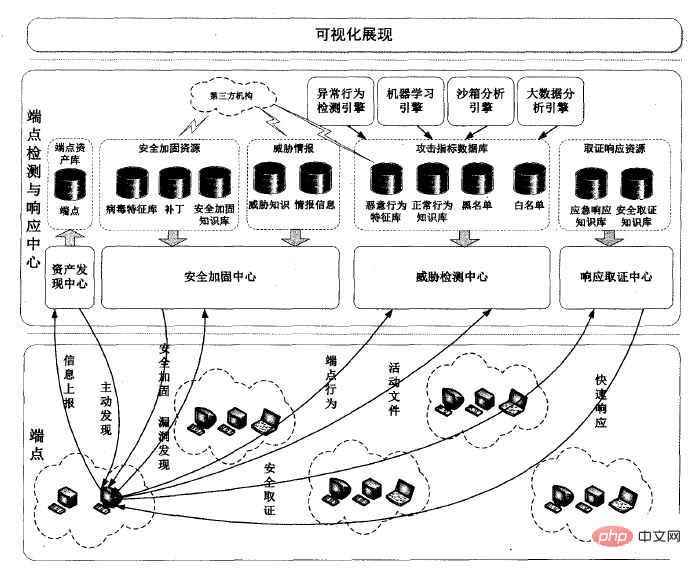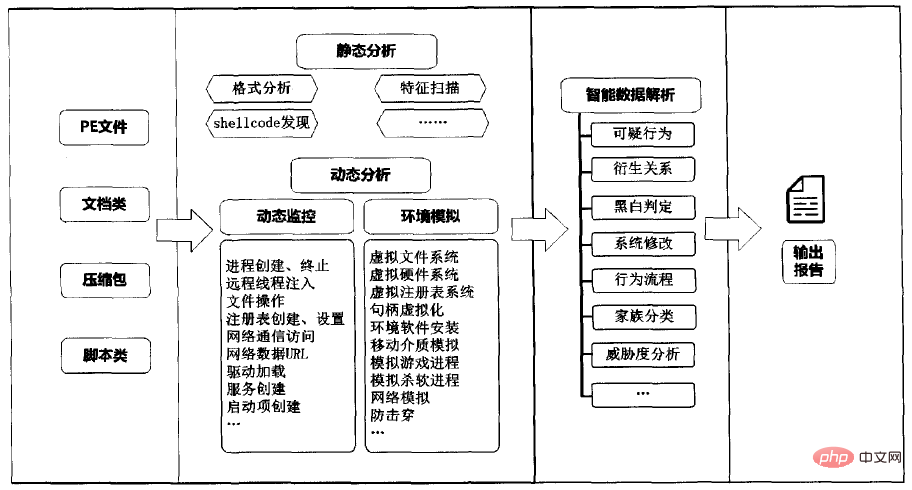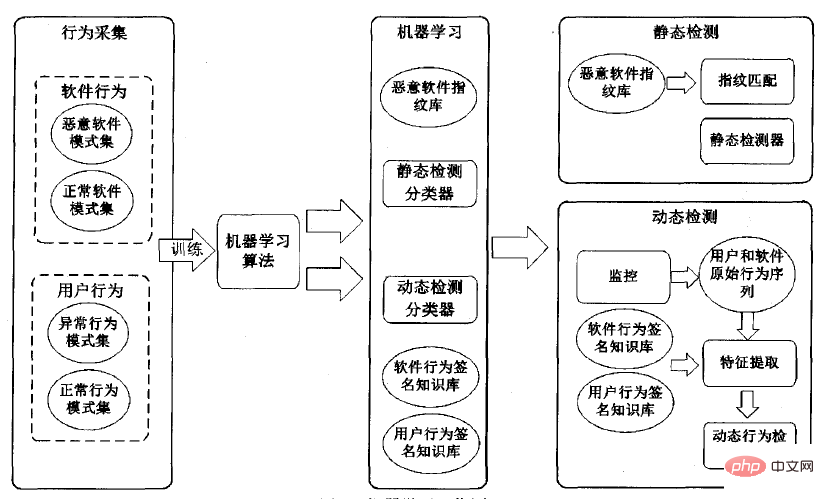
In network security, EDR refers to "Endpoint Detection and Response". It is a proactive endpoint security solution that includes real-time monitoring and the use of automatic threat response mechanisms to collect endpoint security data; by recording terminals and networks Events, store this information locally on the endpoint or centrally in the database. EDR will collect known attack indicators, behavioral analysis databases to continuously search data and machine learning technology to monitor any possible security threats and respond quickly to these security threats.

The operating environment of this tutorial: Windows 7 system, Dell G3 computer.
Endpoint Detection & Response (EDR) is a proactive endpoint security solution that records terminal and network events and stores this information locally on the endpoint or centrally in a database. EDR will collect known attack indicators, behavioral analysis database to continuously search the data and machine learning technology to monitor any possible security threats and respond quickly to these security threats. It also helps to quickly investigate the scope of the attack and provide response capabilities.
Capability
Prediction: risk assessment; anticipate threats; baseline security posture (Baseline Security Posture).
Protection: harden systems (strengthen the system); isolate system (isolate system); prevent attacks (prevent attacks).
Detection: detect incidents; confirm and prioritize risk. contain incidents.
Response: remediate; design policy change; investigate incidents.
Security model
Compared with static defense technology that uses preset security policies for endpoint security protection, EDR The threat detection and response forensics capabilities have been strengthened to quickly detect, identify, monitor and process endpoint events, thereby detecting and blocking threats before they cause harm, and helping protected networks to protect against zero-day threats and various emerging threats. The security model is as shown in the figure:
1. Asset discovery
is regularly collected through active scanning, passive discovery, manual entry and manual inspection. All software and hardware assets in the current network, including all endpoint assets in the entire network and the names and versions of software in use, ensure that there are no security blind spots in the entire network.
2. System reinforcement
Needs regular vulnerability scanning, patching, updating and further refinement of security policies, whitelisting currently unauthorized software to run, and restricting through firewalls to Open server ports and services when authorized. It is best to regularly check, modify and clean up internal personnel's account numbers, passwords and authorization information.
3. Threat detection
Carry out abnormal behavior analysis through the local host intrusion detection of the endpoint, and make corresponding protection and protection measures for various security threats before, during and after their occurrence. Detect behavior.
4. Response forensics
Visually display the security threats of the entire network, automatically isolate, repair and rescue threats, and lower the threshold of incident response and forensics, so that there is no need to rely on Emergency response and forensic analysis can be completed using external experts.
Function
Investigate security incidents;
Repair the endpoint It is in the pre-infection state;
detects security events;
contains terminal events;
##How it works
Once EDR technology is installed, EDR will use advanced algorithms to analyze the behavior of individual users on the system and remember and connect their activities. Sensing the abnormal behavior of a certain or specific user in the system, the data will be filtered to prevent signs of malicious behavior. These signs will trigger alarms and then we will determine whether the attack is true or false. If malicious activity is detected, the algorithm traces the attack path and builds it back to the entry point. (Correlation Tracking) The technology then consolidates all data points into narrow categories called Malicious Operations (MalOps), making them easier for analysts to view. In the event of a true attack, customers are notified and given actionable response steps and recommendations for further investigation and advanced forensics. If it is a false alarm, the alarm will be closed, only the investigation record will be added, and the customer will not be notifiedSystem Framework
The core of EDR is:On the one hand, it uses existing blacklists and endpoint static defense technologies based on virus signatures to block known threats. On the other hand, various security threats from the outside or inside can be proactively discovered through cloud threat intelligence, machine learning, abnormal behavior analysis, attack indicators, etc. At the same time, comprehensive detection and response are performed based on the background data of the endpoint, malware behavior, and the overall life cycle of advanced threats, and automated blocking, forensics, remediation, and traceability are performed to effectively protect endpoints.
EDR includes:Endpoint, endpoint detection and response center, and visual display three parts. The system framework is as shown in the figure:

##Endpoint:In EDR, the endpoint only has basic functions such as information reporting, security reinforcement, behavior monitoring, active file monitoring, rapid response, and security forensics. It is responsible for reporting the endpoint's operating information to the endpoint detection and response center. , and execute issued security policies, responses, evidence collection instructions, etc. at the same time.
Endpoint Detection and Response Center:is composed of asset discovery, security reinforcement, threat detection, response forensics and other centers.
Visualization:Provides real-time visibility and controllability for various endpoint security threats, reduces the complexity of discovering and handling security threats, and assists users to respond more quickly and intelligently security threats.
Detect threat types
Feature Types and Collection Types
Main technology
Intelligent sandbox technology
Aiming at suspicious The key technology for code dynamic behavior analysis is to create a strictly controlled and highly isolated program running environment by simulating various virtual resources, run and extract behavioral information during the running of suspicious code, and achieve rapid identification of unknown malicious code.
Machine learning technology
is a multi-disciplinary interdisciplinary knowledge, the core of the field of artificial intelligence, specializing in how computers simulate Realize human learning behavior, reorganize the existing knowledge system by acquiring new skills and knowledge, and continuously improve its own performance. In large-scale data mining processing, patterns can be obtained through automatic analysis, and then these patterns can be used to predict unknown data.
Digital forensics technology
Digital forensics refers to the detection of sufficiently reliable and convincing information that exists on computers, networks, The process of identifying, protecting, extracting and archiving digital evidence in digital devices such as electronic devices. In EDR, digital forensics must overcome key technologies such as cloud computing environment forensics, smart terminal forensics, and big data forensics, automatically locate and collect endpoint intrusion electronic evidence, lower the technical threshold of forensic analysis, and improve the efficiency of forensics and the accuracy of analysis results. It provides technical support for investigating endpoint security incidents and combating cybercrime.EDR Advantages and Disadvantages
Advantages
EDR completely covers the entire life cycle of endpoint security defense. For various security threat events, EDR can carry out corresponding security detection and response actions before, during and after their occurrence. Before a security incident occurs, proactively collect client security data in real time and perform targeted security reinforcement; when a security incident occurs, proactively discover and prevent security threats through various security engines such as abnormal behavior detection and intelligent sandbox analysis; after a security incident occurs , trace the origin through endpoint data.
EDR is compatible with various network architectures. EDR can be widely adapted to various network architectures such as traditional computer networks, cloud computing, and edge computing. It can be applied to various types of endpoints and is not affected by network and data encryption.
EDR assists administrators in intelligently responding to security threats. EDR can automatically complete a series of tasks such as the discovery, isolation, repair, remediation, investigation, analysis and forensics of security threats, which greatly reduces the complexity of discovering and handling security threats, and can assist users to respond to security threats more quickly and intelligently. .
Disadvantages
The limitation of EDR is that it cannot completely replace existing endpoint security defense technologies. EDR has a complementary relationship with traditional endpoint security defense technologies such as anti-virus, host firewall, host intrusion detection, patch reinforcement, peripheral control, and software whitelisting, and is not a substitute.
Technical Prerequisite
If you want to use or better understand EDR, you need to have some knowledge. Only in this way can we better use and understand the principles and usage of EDR.
Familiar with Linux environment, python or shell, Java;
Familiar with hadoop, spark and other big data components;
Familiar with data mining and analysis (such as risk level classification), data statistics technology (such as some confidence calculations), machine learning technology (classification detection, etc.), deep learning technology, big data analysis technology (mainly Correlation analysis), funnel analysis method, etc.
Familiar with mysql or nosql database, centralized storage database, distributed storage database.
For more related knowledge, please visit theFAQcolumn!
The above is the detailed content of What does edr mean in network security?. For more information, please follow other related articles on the PHP Chinese website!